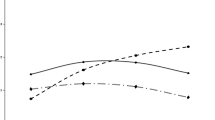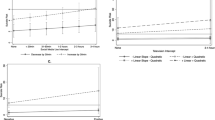Abstract
Objectives
To examine the independent associations between television, computer, and video game use with physical violence in youth.
Methods
The study population consisted of a representative cross-sectional sample of 9,672 Canadian youth in grades 6–10 and a 1-year longitudinal sample of 1,861 youth in grades 9–10. The number of weekly hours watching television, playing video games, and using a computer was determined. Violence was defined as engagement in ≥2 physical fights in the previous year and/or perpetration of ≥2–3 monthly episodes of physical bullying. Logistic regression was used to examine associations.
Results
In the cross-sectional sample, computer use was associated with violence independent of television and video game use. Video game use was associated with violence in girls but not boys. Television use was not associated with violence after controlling for the other screen time measures. In the longitudinal sample, video game use was a significant predictor of violence after controlling for the other screen time measures.
Conclusions
Computer and video game use were the screen time measures most strongly related to violence in this large sample of youth.
Similar content being viewed by others
References
American Academy of Pediatrics (2001) Children, adolescents, and television. Pediatrics 107:423–426
Brener ND, Collins JL, Kann L, Warren CW, Williams BI (1995) Reliability of the Youth Risk Behavior Survey Questionnaire. Am J Epidemiol 141:575–580
Browne KD, Hamilton-Giachritsis C (2005) The influence of violent media on children and adolescents: a public-health approach. Lancet 365:702–710
Bushman BJ, Anderson CA (2001) Media violence and the American public. Scientific facts versus media misinformation. Am Psychol 56:477–489
Canadian Paediatric Society (2003) Impact of media use on children and youth. Paediatr Child Health 8:301–306
Currie C, Samdal O, Boyce W, Smith B (2001) Health behaviour in school-aged children: a World Health Organization Cross-National Study. Research Protocol for the 2001/02 Survey. University of Edinburgh, Scotland
Currie C, Nic Gabhainn S, Godeau N, Roberts C, Smith R, Currie D, Pickett W, Richter M, Morgan A, Barnekow V (2008) Inequalities in young people’s health: HBSC international report from the 2005/2006 survey. Copenhagen, Denmark. World Health Organization Regional Office for Europe
Ferguson CJ (2007) The good, the bad and the ugly: a meta-analytic review of positive and negative effects of violent video games. Psychiatr Q 78:309–316
Ferguson CJ, Kilburn J (2009) The public health risks of media violence: a meta-analytic review. J Pediatr 154:759–763
Ferguson CJ, San Miguel C, Hartley RD (2009) A multivariate analysis of youth violence and aggression: the influence of family, peers, depression, and media violence. J Pediatr 156:904–908
Huesmann LR (2007) The impact of electronic media violence: scientific theory and research. J Adolesc Health 41:S6–S13
Janssen I (2008) Chapter 3: healthy living and healthy weight. In: WF Boyce (ed) Healthy settings for young people in Canada. Public Health Agency of Canada, Ottawa, pp 39–90
Kuntsche EN (2004) Hostility among adolescents in Switzerland: multivariate relations between excessive media use and forms of violence. J Adolesc Health 34:230–236
Mark AE, Boyce WF, Janssen I (2006) Television viewing, computer use and total screen time in Canadian youth. Paediatr Child Health 11:595–599
Marshall SJ, Gorely T, Biddle SJ (2006) A descriptive epidemiology of screen-based media use in youth: a review and critique. J Adolesc 29:333–349
Oleckno WA (2002) Essential epidemiology: principles and applications. Waveland Press, USA
Olson CK (2004) Media violence research and youth violence data: why do they conflict? Acad Psychiatry 28:144–150
Olweus D (1992) Bullying among school children: intervention and prevention. In: Peters RD, McMahon RJ, Quinsey VL (eds) Aggression and violence throughout the lifespan. Sage Publications, USA, pp 127–139
Pickett W, Iannotti RJ, Simons-Morton B, Dostaler S (2009) Social environments and physical aggression among 21, 107 students in the United States and Canada. J Sch Health 79:160–168
Schmitz KH L, Harnack JE, Fulton DR, Jacobs S Jr, Gao LA, Lytle P, Coevering Van (2004) Reliability and validity of a brief questionnaire to assess television viewing and computer use by middle school children. J Sch Health 74:370–377
World Health Organization (2002) World report on violence and health. World Health Organization, Geneva
Acknowledgments
This study was supported by research agreements with the Canadian Institutes of Health Research (operating grants: 2004MOP 84478 and 2004MEP-CHI-128223-C) and the Public Health Agency of Canada (contract: HT089-05205/001/SS) which funds the Canadian version of the World Health Organization—Health Behavior in School-Aged Children Survey (WHO-HBSC). The WHO-HBSC is a WHO/Euro collaborative study. International Coordinator of the 2005–2006 study: Candace Currie, University of Edinburgh, Scotland; Data Bank Manager: Oddrun Samdal, University of Bergen, Norway. This publication reports data solely from Canada (Principal Investigator: William Boyce). IJ was supported by a New Investigator Award from the Canadian Institutes of Health Research and an Early Researcher Award from the Ontario Ministry of Research and Innovation.
Conflict of interest
The authors declare that they have no competing interests.
Author information
Authors and Affiliations
Corresponding author
Rights and permissions
About this article
Cite this article
Janssen, I., Boyce, W.F. & Pickett, W. Screen time and physical violence in 10 to 16-year-old Canadian youth. Int J Public Health 57, 325–331 (2012). https://doi.org/10.1007/s00038-010-0221-9
Received:
Revised:
Accepted:
Published:
Issue Date:
DOI: https://doi.org/10.1007/s00038-010-0221-9




